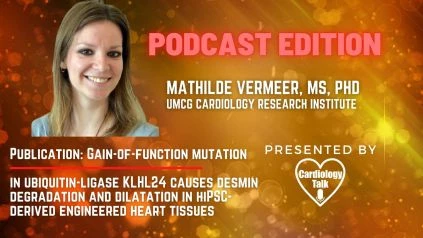Podcast - Mathilde Vermeer, MS @CardiologyUmcg @p_van_der_meer @RegenBio @cmu_bme @mariekebolling @HijackSciJac #Engi...
Mathilde Vermeer, MS, Ph.D. Student at UMCG Cardiology Research Institute speaks about Publication: Gain-of-function mutation in ubiquitin-ligase KLHL24 causes desmin degradation and dilatation in hiPSC-derived engineered heart tissues.
Link to Article:
https://www.jci.org/articles/view/140615
Link to Abstract:
https://www.science.org/doi/10.1126/scitranslmed.abd1817
Abstract:
By skipping the first start codon, the start codon c.1A>G mutation in KLHL24, which encodes the ubiquitin ligase KLHL24, leads in the deletion of 28 N-terminal amino acids (KLHL24-N28). KLHL24-N28 causes gain of function in skin, producing epidermolysis bullosa simplex by overly targeting intermediate filament keratin-14 for proteasomal breakdown (EBS). Dilated cardiomyopathy (DCM) is found in the majority of EBS patients, although the pathogenic process in the heart remains unclear. We predicted that KLHL24-N28 causes excessive desmin degradation, resulting in DCM, because desmin is the cardiac analog of keratin-14. Dynamically loaded engineering heart tissues (dyn-EHTs) were created from cardiomyocytes produced from human induced pluripotent stem cells (hiPSCs) from two patients and three nonfamilial controls. Desmin protein levels were shown to be tenfold lower in patient-derived dyn-EHTs, which corresponded to decreased desmin levels seen in patients' explanted hearts. Tissue dilatation, reduced mitochondrial function, lower force values, and higher cardiomyocyte stress followed this. KLHL24-mediated desmin degradation was verified in HEK293 transfection tests. Desmin protein levels were restored in patient-derived dyn-EHTs via KLHL24 RNA interference or direct desmin overexpression, restoring shape and function. To summarize, the presence of KLHL24-N28 in cardiomyocytes causes excessive desmin degradation, which affects tissue shape and function and may be avoided by restoring desmin protein levels.
Overview:
Inherited cardiomyopathies are common illnesses with a wide range of causes. New causal genes are found on a regular basis. We think we were the first to discover a connection between the KLHL24:c.1A>G mutation (Met1Val), which causes epidermolysis bullosa simplex (EBS) in the skin and dilated cardiomyopathy (DCM) in the heart (1). Around 33 individuals with identical gain-of-function mutations leading to DCM have been documented since our first finding (2, 3). Despite these reports, the causal consequences of KLHL24 gain-of-function mutations in cardiomyopathy have yet to be determined.
The KLHL24:c.1A>G mutation is one of five known methionine start codon mutations in ubiquitin ligase KLHL24 (c.1A>G, c.1A>T, c.2T>C, c.3G>A, and c.3G>T), which results in the loss of 28 N-terminal amino acids (KLHL24-N28) by bypassing the first start codon. KLHL24 acts as a ubiquitin ligase in the epidermis, creating a protein complex with CUL3 and RBX1 to facilitate keratin 14 degradation. Through KLHL24 auto-ubiquitination, this process is kept in check. The mutant protein KLHL24-N28, on the other hand, is unable to perform auto-ubiquitination and hence is more stable. Excessive ubiquitination and, as a result, breakdown of keratin 14 occurs, resulting in skin fragility.
Keratins (KRT) are intermediate filaments (IFs) proteins that are required for the cytoskeletal network of keratinocytes in the skin. When cells are stretched, IFs provide cells with flexibility to minor deformations while also strengthening them (8). EBS and hereditary cardiomyopathies have been linked to mutations in genes encoding various IFs, which play important regulatory functions in stretch-bearing tissues including the skin and the heart (9, 10). In cardiomyocytes and skeletal muscle cells, Desmin (DES) is a crucial IF (11). Desmin filaments connect myofibrils and expand the z-discs, producing a supporting latticework that runs from the sarcolemma to the nuclear envelope. They help to orient, stabilize, and transmit signals between the nucleus, cell membrane, mitochondria, and myofibrils. Mitochondrial dysfunction is one of the first and most visible abnormalities when the IF network in the heart is disrupted. Desmin network failure also causes nuclear delamination and intercalated disc abnormalities, which eventually contribute to heart function loss. Desminopathies have been linked to a number of DES mutations as well as mutations in other genes that impact the desmin network.
We predicted that KLHL24-N28 causes excessive desmin degradation in the heart, resulting in DCM, because desmin belongs to the same highly conserved intermediate filament protein family as keratins (15). We employed human induced pluripotent stem cells (hiPSCs) to differentiate patient-specific KLHL24WT/c.1A>G cardiomyocytes to test this notion. A dynamically loaded engineered heart tissue (dyn-EHT) model was used to investigate the role of KLHL24 in cardiac tissue compliance (i.e., stretching the desmin network) (16). To replicate the stress (preload and afterload) experienced by the heart, a polydimethylsiloxane (PDMS) strip is connected to engineered heart tissues (EHT). Finite element modeling may be used to calculate tissue contractile force by bending the strip (FEM). This system can also be dynamically grown, allowing researchers to see the morphological and functional changes that occur during ventricular dilation, which was crucial in identifying a clinically relevant phenotype in desmoplakin-mutated hiPSC-CMs (16). We show that a gain-of-function mutation in KLHL24, which results in KLHL24-N28 and causes excessive desmin degradation in cardiomyocytes, negatively affecting the shape and function of dyn-EHTs, may be avoided by KLHL24 RNA interference or direct desmin overexpression.
Outcomes:
EBS in families with dilated cardiomyopathy. Two patients of Dutch descent, both carriers of the KLHL24:c gene, were included in this research. Figure 1A, II:3, and III:2 show the 1A>G mutation (1). KLHL24-N28 is a shortened KLHL24 protein caused by this mutation (Figure 1B). Both patients had EBS and exhibited characteristic aplasia cutis congenita and skin fragility that improved with time. Furthermore, at the age of 17, the index patient (II:3) was diagnosed with a fast-progressing type of DCM, for which he had a heart transplant at the age of 18. His son (III:2), who was 18 years old at the time of the research, was still asymptomatic, but his echocardiography revealed clear indications of DCM, including left ventricular (LV) dilatation, decreased LVEF, and impaired global longitudinal systolic strain.



